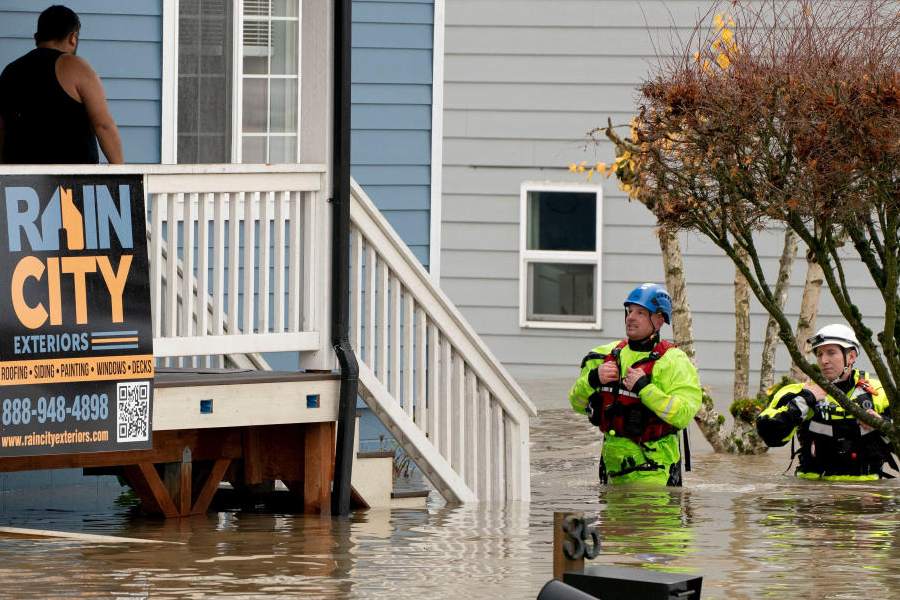 Friday, 12 December 2025
Friday, 12 December 2025
 Friday, 12 December 2025
Friday, 12 December 2025
One common adaptation technique, in India and other countries hit hard by rising seas and oceanic storms, is to build sea walls. While they provide a barrier that seas have to get over, scientists and climate adaptation experts warn that such structures can only provide so much protection.
Nearly two years ago, Mary Sebastian (center in the picture) was hoisted on a chair and carried by a policeman in waist-deep floodwaters, leaving behind her now damaged home where she had spent more than 70 years of her life. She never thought she would return. So, when Sebastian, now 85, recently recounted her experience during Cyclone Tauktae, which hammered parts of southern India in May 2021, she became emotional as the memories came rushing back. Having returned to the same tiny, tiled-roof home, she expressed hope that a sea wall being erected on the coast just in front of her house would check raging waves of the Arabian sea and keep her safe.
Hima Rose, left, and neighbor Reetha Maria, talk in Kochi, Kerala, India, March 4, 2023, about their experience during Cyclone Tauktae in 2021. "I was shocked to see waves carrying huge granite stones of the old sea wall and tons of water gushing directly to my home," Maria said. "You may have no idea how many days that we took to clean the stinking mud and filth brought by the seawater."
Hima Rose, 29, showed her balcony garden, where a hybrid mango tree and curry leaf plant among some other such fauna, are planted on colorful pots. "This is nothing but post-cyclone impact," she said with a smile. "We don’t want to lose our darling plants to yet another cyclone and high waves. So, we decided to grow them on the balcony. Luckily, we have a two-story house." Rose said that after Tauktae, she welcomed neighbours to her home, providing them shelter and food for several days.
Like many native dwellers of Chellanam, a fishing hamlet of 40,000 people in Kerala, Sebastian is living with fears of many weather events exacerbated by climate change: cyclones, surging seas, flooding and erosion. Tens of millions of people in India, this year expected to become the world’s most populous nation, live along coastlines and thus are exposed to major weather events.
A boy plays on a home near a newly built sea wall in Kochi, Kerala, India, on March 4, 2023, that was abandoned after the 2021 Cyclone Tauktae. The house remains a constant reminder of the harrowing aftermath of the cyclone's sea surge, displacements and relief camps.
At least 10,000-12,000 residents are affected by the coastal erosion and extreme wave issues every year, according to K L Joseph, former president of Chellanam’s village council.
Joseph said Chellanam has tried other methods to protect homes and people, such as a large project some years ago involving geotubes. Laid along coastlines, tubes made of polymer are filled with sand, thus providing a barrier that is flexible to accommodate waves. But parts of the tubes broke apart, with local news reports recounting how chunks were washed out to sea.
"It failed," Joseph said of the project.
Less-than-certain protection isn’t the only downside of any kind of sea barrier. Erecting a structure to keep waves in check simply means the water, pushed back to sea, will go somewhere else, potentially creating higher surf in other parts of nearby coastlines, which may not have sea walls. Sea walls also limit, or altogether remove, a beach area. Fishermen in Chellanam have already had to move where they dock their boats. Joseph Mathew, a Kerala-based coastal protection expert, said the loss of the beach will disrupt Chellanam's ecosystem. For example, waves hitting the sea wall will be pushed toward the ends of the wall, creating higher surf, and thus erosion, in those areas.
For years, Chellanam witnessed intense protests demanding that authorities provide a more permanent solution to protect the shores. Last year, Pinarayi Vijayan, the state’s chief minister, inaugurated a new coastal protection project that included a sea wall made of concrete structures called tetrapods and a network of groynes, low barriers built from the coast into the sea. Today, heaps of dusty granites and tetrapods, weighing between 2,000 to 5,000 kilograms line broken pathways and vacant plots near the Chellanam coastline, about 20 kilometres from the port city of Kochi. A chain of six T-shaped groynes is also under construction.
"DANGER. STAY OUT FROM SUSPENDED LOADS," warns a sign with an image of a stickman potentially being crushed by a tetrapod. With much of the first phase of the new sea wall completed in a 7-kilometre stretch from Chellanam harbour to Puthenthodu Beach, at least for now residents like Sebastian feel more secure. She and other family members living with her — a son, daughter-in-law and two grandchildren — are still processing painful memories from the cyclone that washed away their savings and many dreams.
Today, construction work on the sea wall is almost complete in Kandakkadavu.
As the sun sets in the evenings, children climb the slanting granite structures and sit atop the tetrapods. An abandoned one-story house, battered by the cyclone, remains standing just some meters (yards) away from the sea wall, a constant reminder of the harrowing aftermath of the cyclone’s sea surge, displacements and relief camps. For those who can't afford to leave their homes, and live and work along the coast, the construction of the sea wall is priceless but not a complete fix, as workers race to finish before the next monsoon, which could be any day now.







